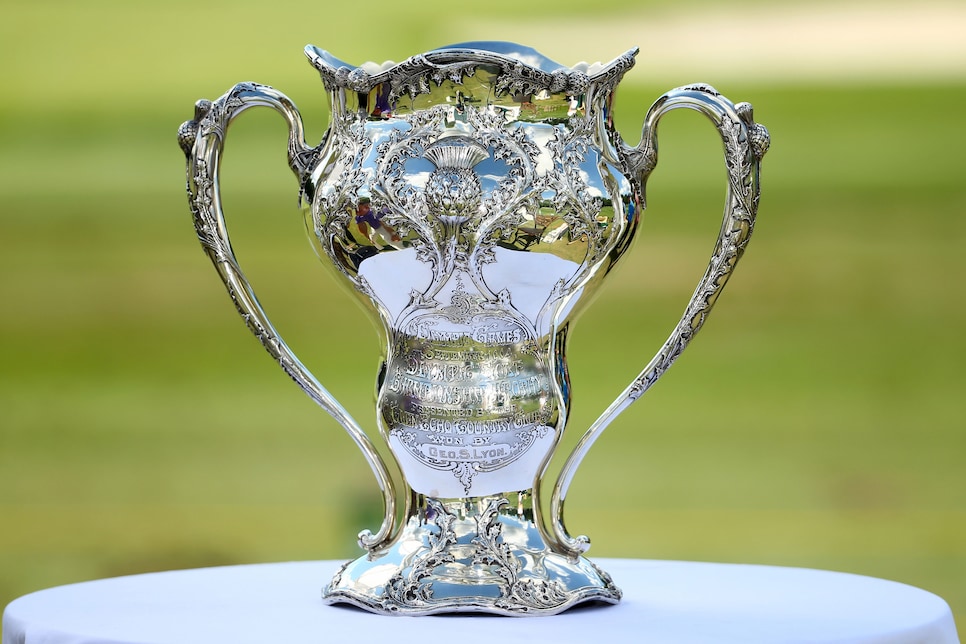If you like golf trivia, here’s a fun one that your friends will almost definitely not know, but will inevitably lead to a round of head-smacking when you reveal the answer:
In the 1904 Summer Olympic Games in St Louis, a retired cricket professional named George Lyon won a gold medal as one of just three Canadians competing in an event that included 72 Americans. (No other nations participated.) Who was the next man to win an Olympic gold medal in Lyon’s event?
Your mind goes straight to the year 1908, and you think, How would anyone know that? But in fact George Lyon was competing in golf, which wouldn’t appear in the Olympics again for more than a century. To arrive at the answer, you have to travel forward in time 112 years to 2016, when Justin Rose won the gold medal at the Rio Olympics.
Who, you might be wondering, is George Lyon? It’s a great question, because aside from his moment of Olympic glory, he doesn’t register very often in the historical record. When golf historians talk about the sport in the early 20th century, they focus on the British superstars of the time, from Willie Anderson to Harry Vardon to James Braid. A Scot named Jack White won the Open Championship in June that year, Anderson, another Scot, won the US Open a month later, but neither of them stuck around until late September to play at Glen Echo Country Club in St Louis for the honour of winning gold at the third Olympiad.
In fact, almost nobody came to those Games other than the US and Canada. They were originally scheduled to be in Chicago, but St Louis managed to enrage the IOC by leveraging the World’s Fair it was hosting and striking a deal with the AAU to host the track and field championships there. The fair organisers publicised plans for a kind of shadow Olympics, and by doing so essentially strong-armed the IOC into sending its first non-European Olympics to St Louis. All of which led to this great quote from a very annoyed Pierre de Coubertin, founder of the modern Olympics: “I had a sort of presentiment that the Olympiad would match the mediocrity of the town.”
Ouch. The difficulty and expense of travel at the time, the on-going Russo-Japanese War and the spectre of poor organisation in St Louis contributed to a dearth of foreign athletes. The numbers differ depending on the source, but it’s safe to say that more than 600 athletes competed at the St Louis Games, only about 100 of them from outside America, and most of those 100 were Canadian. The competition lasted an absurd five months, the organisation was indeed a shambles, and historically it’s not always easy even to this day to determine which events held in St Louis in that timeframe period were actually part of the Olympics. A classic example of how bad it got came in the marathon, where 18 of 32 runners dropped out (most due to exhaustion but one of whom was attacked by dogs), the original “winner” actually hitched a ride for 16 kilometres of the race, and the actual winner was dosed with strychnine to keep him on his feet during the race.
Enter golf. This was the second time the sport had been contested at the Olympics, but no medals were given out in 1900 (American Charles Sands is listed officially, though, as a gold medal winner) and many of the competitors didn’t even know they were in the Olympics that year in Paris. Technically then, this gold medal Lyon won in 1904 would be the first. And not only did the event not attract the best British golfers in the world, but most of the best east-coast American players turned their noses at the concept of journeying inland. Which meant that the field mostly included amateurs from the midwest. Again, numbers vary depending on the source, but there were between 75 and 77 golfers, and all but three were American. Those other three were friends from Toronto who made the 1,200-kilometre trip.
One of the Canadians was 46-year-old insurance salesman George Lyon, and to win the gold medal, he had to qualify among the top 32 over 36 holes of strokeplay, then advance through five rounds of a matchplay bracket (yes, Olympic golf has a matchplay tradition that many wish it would return to, but I digress). Interestingly, each round of matchplay was a punishing 36 holes.
What makes Lyon’s story even more far-fetched is that he wasn’t even known for golf. Lyon was a cricketer, and a very good one, at one point holding the Canadian record for the highest score. He was also good at seemingly every other sport he tried, including pole vault, in which he set a Canadian record as a young man. He began to play golf either at age 37 or 38 – again, the charm and difficulty of these very old sports is that records are not up to the pristine standards of modernity, and in fact the Golf Canada website has him starting golf at 38 in one paragraph and 37 the next – and had been playing less than a decade when he made the trip to St Louis.
That said, when he took to the sport, he really took to the sport. By 1904, he had already won three Canadian Amateur championships, and he would go on to win many more and to triumph in Canadian Senior championships up to age 72. To add to the mythos surrounding him, he was diabetic and suffered from hay fever. Nevertheless, he qualified for the matchplay with a two-day score of 169, and in the bracket he was one Canadian among 31 Americans. He proceeded to stun his opponents with the surprising power emanating from what was apparently a very ugly swing. Newspaper accounts of the time compared the swing to someone shoveling coal, but his athleticism was nevertheless evident, with one writer calling him “a veteran whose sinews are of iron, and with a temperament as phlegmatic as an Algonquin Indian”.
His first three matches were cakewalks, and he guaranteed himself at least a silver with a 1-up victory in the semi-finals. In the final he faced reigning US Amateur champion, Chandler Egan. Lyon reportedly drove the green on the 250-metre first hole, rattling Egan and leading to a shocking 3&2 win for the gold on a cold, wet day. If you believe contemporary reports – and it is certainly in keeping with the general strangeness of those Olympics – Lyon accepted the trophy by walking on his hands across the Olympic stage while singing his favourite song, “My Wild Irish Rose.” The silver trophy he won still exists; the gold medal is lost.

Lyon went on to compete in the 1906 US Amateur, where he reached the final before losing to a socialite named Ebenezer Byers, who – it’s hard to resist the weirdness of history – died in 1932 after consuming a medicine called Radithor made of dissolved Radium. (When his body was exhumed 30 years later, the remains were still highly radioactive.) Lyon also competed in the 1908 British Amateur, and this was likely on the same trip he took to defend his gold medal at the 1908 Olympics in London. There, the event was cancelled at the last moment due to a dispute between various governing bodies (including the R&A) and, apparently, some faulty entry forms. Lyon was informed about the cancellation when he showed up, and because his entry form was correct, he was offered the gold medal that had already been made. He declined.
Lyon had an illustrious late career in Canada, but seems not to have competed very often outside his country’s borders after that. It’s interesting to engage in hypotheticals and wonder what he could have achieved with access to the best tournaments in the world. What we know for sure, though, is that he seized a strange opportunity in 1904, defeated a slew of Americans on their home soil and held the title of golf’s last Olympic gold medallist for more than a century. Not bad for a 46-year-old retired cricketer.




